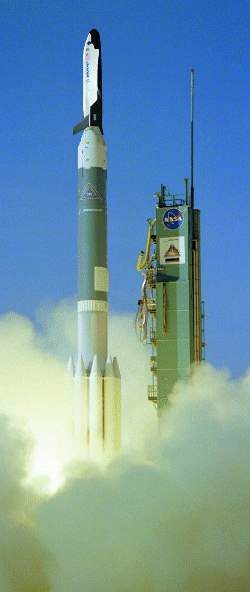GRAHAM WARWICK / WASHINGTON DC
Boeing and Lockheed Martin immediate winners from Space Launch Initiative restructure
Industry has welcomed NASA's decision to restructure its Space Launch Initiative (SLI) to focus on the Orbital Space Plane (OSP) and delay development of a next-generation reusable launch vehicle (RLV). Boeing and Lockheed Martin are immediate beneficiaries, receiving contracts to demonstrate technologies for the OSP.
Boeing's $300 million contract revitalises its X-37 reusable spaceplane technology demonstrator programme. The deal includes funds to complete the approach and landing test vehicle now in final assembly and build an orbital test vehicle to be launched on a Boeing Delta expendable booster.
Assembly of the first X-37 will be completed early next year, says Kevin Neifert, director of Boeing's advanced space and launch systems division. Avionics and other systems will be installed following structural tests, and atmospheric flight tests are to begin in March 2004, culminating in drop tests from NASA's Boeing B-52.
The second X-37 will be strengthened for unshrouded launch on a Delta II, or possibly Delta IV, says Neifert. The reusable vehicle will operate in orbit for around a month. Multiple orbital flights are planned from mid-2006 to test autonomous re-entry and landing, high-temperature structures and thermal protection systems.
Lockheed Martin, meanwhile, has received a $53 million contract to build a launch pad abort testbed to demonstrate crew escape technologies for the OSP, which is to be launched on a Delta IV or Lockheed Martin Atlas V Evolved Expendable Launch Vehicle. Ejection seats and ejection capsules are among escape mechanisms being studied to reduce the probability of crew loss on an expendable launch.
Testing of candidate technologies is to begin in mid-2005, although NASA has to decide which escape mechanisms to demonstrate, says Bob Ford, Lockheed Martin SLI programme manager. To meet the loss-rate requirement, systems are required that will allow the crew to escape during the ascent and descent phases, as well as on the launch pad.
The OSP is set to enter service in 2010, launched unmanned as a crew rescue vehicle to the International Space Station. By 2012, the spaceplane will ferry crewmembers to the ISS. Work on a second-generation RLV will continue under the Next Generation Launch Technology programme, with a decision on development delayed until 2009.

Source: Flight International























